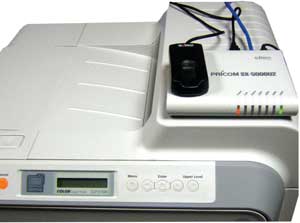GCN Lab Review | For better security, touch your printer


Connecting state and local government leaders
Security is more than just passwords on your desktop. Every agency knows physical security is just as important. However, within a department there is normally not much to protect documents from users already in the building. And that can cause trouble.

NO KEYPAD NEEDED: The Silex Secureprint applies fingerprint biometrics to printer security.
The most obvious problem
comes when a document is
printed on a shared printer.
Even a document that originated
on a secure desktop within a
locked office becomes vulnerable
when it is sent to a printer
down the hall. Just because someone
works with you doesn't mean they have the
same need or right to read a document.
Moreover, there could be cleaners or other
visitors in the area.
By the time you
get to the printer, someone might have
read or taken your sensitive document.
Secure printing is a feature we're starting
to see on a lot of new printers. When a user
prints a document, they are usually asked to
assign it a code, which must be entered via
a keypad on the printer to release the job.
This is a good feature, but the keypad
method has some limitations. And you
might not have $10,000 or more to purchase
a new network printer with this feature,
even if you need a secure environment.
The SecurePrint kit from Silex Technology
can help set up a secure printing environment,
protected with a biometric fingerprint
sensor, even if your printer is not
currently designed for it. All the printer
needs is a USB port.
The kit comprises an SX-5000U2 multiport
USB Device Server and a Silex fingerprint
reader. Setup in the GCN Lab
was relatively easy. We simply plugged the
Silex fingerprint reader into the print
server and then attached the printer the
same way. With both the fingerprint sensor
and the printer plugged into the server,
there were still two free USB ports.
These can be hooked to other printers if
you have them nearby.
Once you have the fingerprint reader and
the printer plugged into the print server,
you then connect an Ethernet cable from
the server to the network. You may have to
change some settings on client computers
at this point, since the IP address of the
printer may be different now that you are
using the print server as a hub.
Once this was complete, we
had a working print server, and
all the printers connected to it
could be accessed normally
using standard desktop menus.
To activate secure printing,
you need to install Silex software
on each client that
needs the feature. Then you
need to enroll your fingerprints
with the system. The
easiest way to do this is to
bring the fingerprint sensor
over to your client PC, which
needs to have a USB port.
The kit comes with only one
fingerprint reader, though
others can be purchased.
You can then enroll one or
several fingerprints with the
system. Only the minutiae of
your print is stored on your
system, so if you're worried about someone
getting your print out of the system, it
won't happen. The minutiae are a series of
points on your fingerprint that means
something to the program but not to anyone
else. All users will have to enroll themselves
at their client PCs. The enrollment
process on a Mac is only slightly different.
Once you are enrolled and the fingerprint
sensor has been returned to the
print server, you're ready to print files securely.
When you print a document, you
specify that you'd like to activate the biometric
security. Once the document has
been sent, you need to run a program
called SX Virtual Link. This links your
PC to the fingerprint reader, which is
stored at the printer. When you are
ready, walk down to the
printer and place your finger
on the reader.
The reader compares your
print with the minutiae stored
back at your PC and if there is a
match, releases the document
to the printer. The SX Virtual
Link application automatically
terminates and disconnects
once a document is released.
The setup and management
of the secure print process is
not the most elegant we've
seen, but considering you're
MacGyver-ing a secure biometrics
application onto an
unsecured environment, it
works surprisingly well. And
you can upgrade your security
without having to buy a new
batch of printers.
At the very least, you can use
the kit as a stopgap method until you can
purchase a full-scale network printer with
secure printing capabilities, though once
you go through the long install process, you
have created a secure environment that is
easy to live with.
NEXT STORY: Tech Briefs




